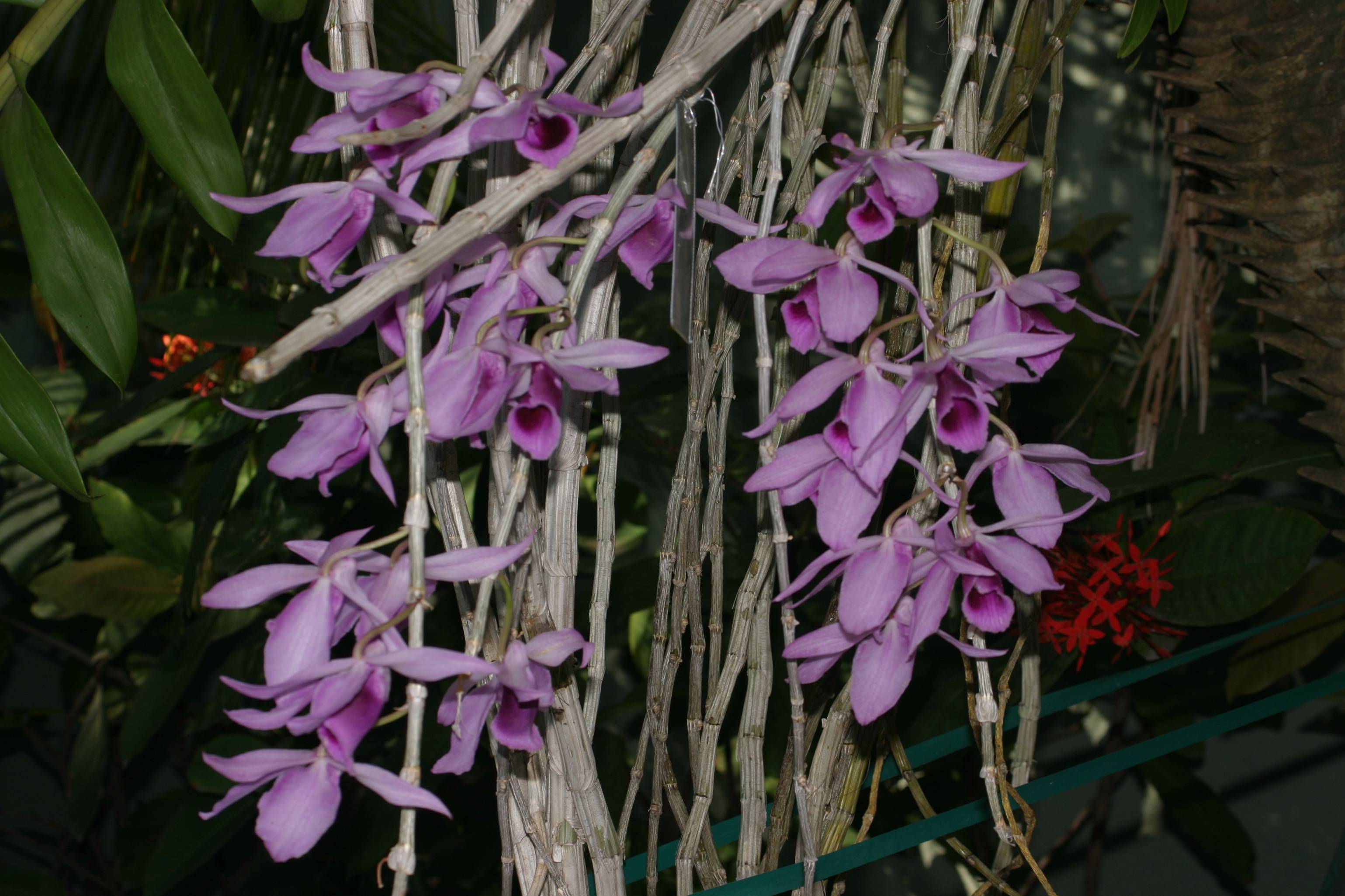Plant Spotlight: Dwarf Poinciana
by Dick Dutton, Plant Curator
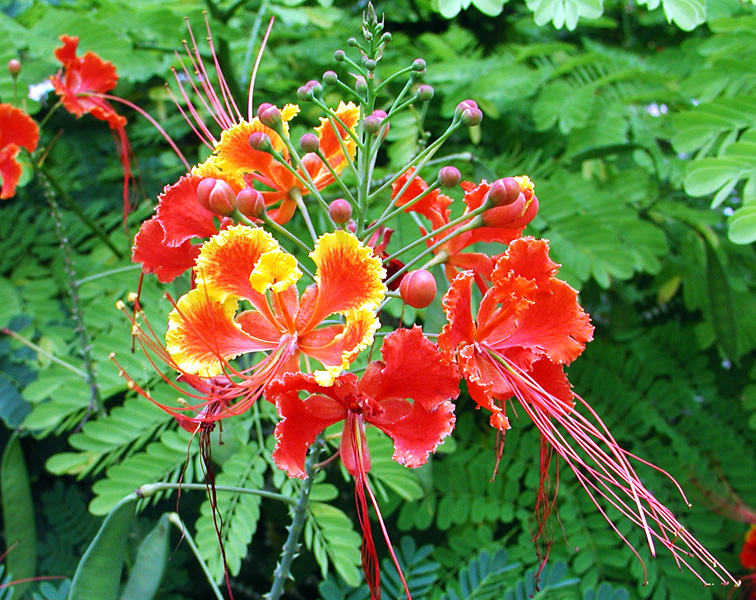
The Dwarf Poinciana is a large shrub/small tree that has flowers resembling a Royal Poinciana tree with the advantage of a smaller size. The Royal Poinciana, considered by some the most beautiful flowering tree in the world, is large and can reach 30′ in height with a 50′ spread. This makes the Dwarf Pionciana perfect for smaller yards or lanais where space is limited.
Dwarf Poincianas grow to 8-12 feet and are semi-deciduous, losing their leaves during the winter for a relatively short time. They are easy to grow from seed; germination takes no more than seven days during the warmer weather. There is one tree on the Edison and Ford Winter Estates grounds by the fountain on your way to Edison’s Pier.
Dwarf Poincianas are very popular and are available for sale in the Estates Garden Shoppe located near the Information Booth.
Plant Spotlight: Candlenut Tree
by Dick Dutton, Estates Plant Curator
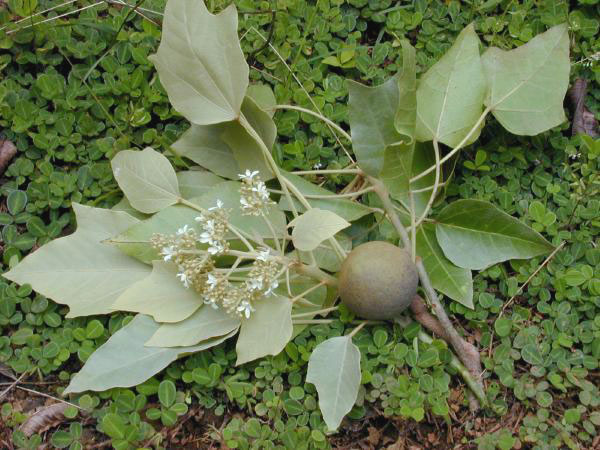
Candlenut Tree, Aleurites moluccana, Euphorbiaceae, Old and New World Tropics
The Candlenut tree is the state tree of Hawaii. It is one of the few trees that has a motto: “Peace, Security and Enlightenment.” The Candlenut tree can grow to 75 feet tall, bears walnut-size nuts and has evergreen leaves resembling the maple in shape.
Parts of the nut are used for cooking, traditional medicine, and soaps. Ancient Hawaiians used the nuts to provide light by stringing them in a row on a palm leaf midrib, lighting one end, and burning them one by one approximately every fifteen minutes. This led to their use as a measure of time, as one could instruct someone to return home before the second nut burned out.
There are three trees growing on the Edison and Ford Winter Estates. Candlenut trees are available for sale at the Garden Shoppe.
Neighborhood Walks Yield Scented Treasures
by Debbie Hughes, Estates Horticulturist
Take a walk around the neighborhood and open your eyes and your nose. Many of our great wonders can’t be found while driving in a car. Get out of the house in the summertime – I find the cooler night time is the perfect time.
I walk around my neighborhood every night accompanied by my 6 pound dog, a silver-colored energetic Yorkshire terrier named “Roxy”. A dog is a great companion to make you exercise when you would rather be lazing around the house. While we were turning round the last corner before heading home on this dark humid evening, an intriguing smell wafted past my nose. What could this be? I looked around knowing Roxy couldn’t help (she was only interested in dog smells). I knew this had to be some night-time pollinator attractor flower. As I walked a few more steps, there shining in the evening moonlight was the luminescent blooms of the Angel Trumpet. It appeared to be the apricot/salmon colored variety.
The angel trumpet works so hard to get the attention of the moth, the pollinator of these heady flowers. Many flowers need more than a night-time glow; they need fragrance. Angel trumpets are classified as vespertine flower is one which opens and blooms in the evening. The Brugmansia genus, botanically speaking, blooms off and on throughout the warm months usually 4-6 weeks apart. The Estates has two large (6 foot) angel trumpets standing guard at the entrance to the Moonlight Garden. There is a foot long white flowered variety also in another area of the gardens.
-
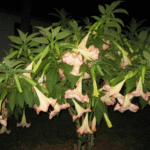
-
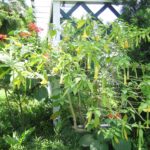
The most certain way to enjoy all that nature has to offer is to get out of the house and capture real life adventures. The olfactory senses don’t work on the television. We often take cuttings from the Angel Trumpets and offer them up for sale at the Estates Garden Shoppe or at the Downtown Farmer’s Market. If you can’t grow these plants at home become a member at the Estates so you can regularly observe all the goodies growing.
Orchids in Bloom
by Debbie Hughes, Estates Horticulturist
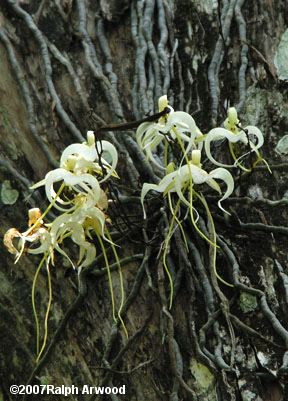
I was fortunate enough last weekend to visit the strange Ghost orchid at the Audubon’s Corkscrew Swamp Sanctuary near Naples, FL. The term “visit” usually describes catching up with an aunt or uncle, but this visit was more like a long lost friend. A Dendrophlax Lindenii, botanically speaking, is a rare orchid native to South Florida composed of roots (no leaves) and an odd-shaped white petaled bloom spike.
To view the ghost orchid one had to squint through a scope. The orchid was perched in its roost, 300 feet from the boardwalk, high in the sky in an unsuspecting 600 year old cypress tree. I couldn’t believe my eyes; the orchid really existed! My previous experience came up empty while hiking through the Fakahatchee Swamp in the Everglades years earlier. I also discovered oodles of orchids attached to pond apple trees within naked eye view while strolling on the boardwalk. Most people might not notice the orchids, mistaking them for tree parts. I wonder what fate native orchids have in South Florida, as the numbers have dwindled throughout the state and the world since people began collecting them and developing the lands on which they thrive.
Every week, we attach orchids into our mango trees and other appropriate trees at the Edison and Ford Winter Estates in what we call “Orchid Lane”. Orchids were a favorite of Mina Edison; many horticulturists hunting the wilderness and friends worldwide sent her orchids. There was even talk of the Edisons’ and Fords’ camping forays into the swamps bringing orchids home to their gardens. The rough crevices of the bark make mango trees a perfect candidate for the orchid to establish a network of roots in. The canopy also provides protection from strong winds and direct sunlight.
Laelias, Cattleyas, Cyrtopodium, Dendrobiums, Phaleanopsis, Schomburgkia, Psychopsis, Dendrophylax, Epidendrum, Oncidium, Encyclias, Brassavola, Vanilla, and everything in between reside in the loving arms of our tropical jungle. We are a designated site for confiscated orchids through CITES (Convention on International Trade in Endangered Species of Wild Fauna and Flora). Since we receive many rare and not-so-rare orchids, we are able to provide a chance for the public to enjoy these beauties close up.
Each month an orchid will find a reason to bloom and continue the cycle of life. We have a Dendrobium that has bloomed continuously since I began work here in 2007. Just come by and walk around the property; you will be amazed at the fun you will have discovering our hidden wonders. During the year we offer an Orchid class for those who would like to learn about their care. Stay tuned for more info about our amazing orchids throughout the year!
